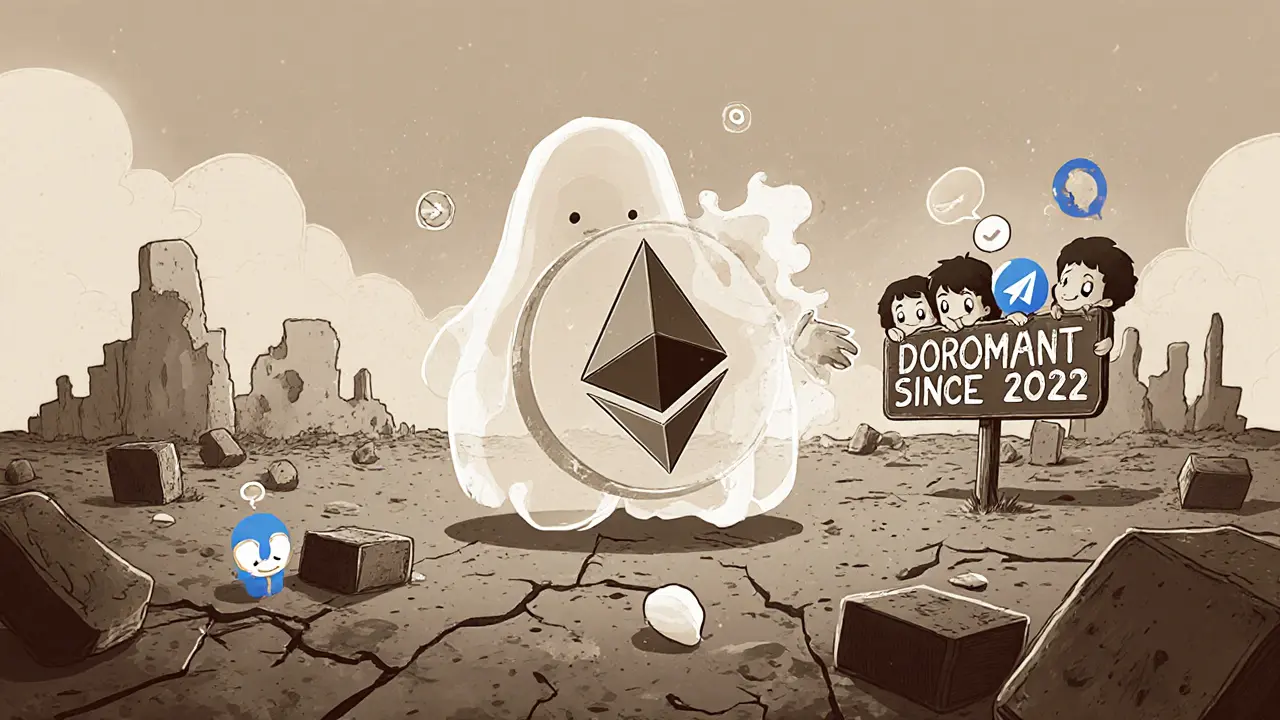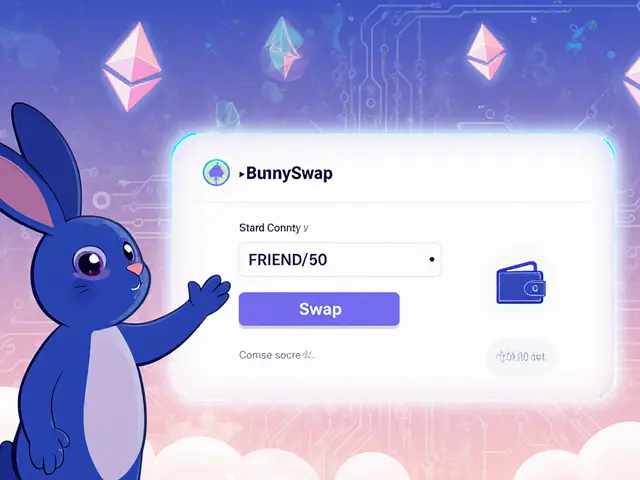
OpenDAO (SOS) Token Value Calculator
Calculate Your SOS Token Value
OpenDAO (SOS) is a cryptocurrency that was distributed as a free NFT airdrop in 2021. At its peak, it gained over 1,200% in value, but now trades at a fraction of its peak price. This calculator shows the current value of your SOS tokens based on the latest market data.
About SOS tokens
OpenDAO (SOS) is no longer actively developed and has minimal liquidity. It's primarily considered a historical artifact from the NFT boom.
Current market price: $0.00000215
Peak price: $0.000026 (over 1,200% gain)
Value at peak: $0.000026
OpenDAO (SOS) wasn’t built to be the next Bitcoin. It wasn’t even meant to be the next ApeCoin. It started as a simple idea: reward people who traded NFTs on OpenSea. On Christmas Day 2021, anyone who had bought, sold, or traded an NFT on OpenSea got a free slice of 100 trillion SOS tokens. No sign-up. No fees. Just a digital thank-you note written in code. At first, it felt like winning the lottery. The price spiked over 1,200% in days. But that hype didn’t last. Today, SOS is barely trading. Most people who claimed it don’t know what to do with it. And no one’s building anything new around it.
How OpenDAO (SOS) was born
OpenDAO launched on December 25, 2021, as an ERC-20 token on the Ethereum blockchain. It had no team, no CEO, no whitepaper with fancy charts. Just a Medium post announcing an airdrop to OpenSea users. If you’d traded even one NFT on OpenSea before December 1, 2021, you were eligible. The more you traded, the more SOS you got. Over 189,000 wallets claimed tokens before the deadline on June 30, 2022. That’s one of the widest distributions ever for a crypto project.
The token supply was fixed at 100 trillion SOS. Half went to users. Twenty percent was locked for staking rewards. Another 20% went into the DAO treasury - meant to fund NFT artists, compensate scam victims, and support developers. The last 10% was for liquidity pools on Uniswap. No burning. No inflation. No hidden rules. It looked fair. Too fair, some would say later.
What SOS was supposed to do
The project called itself "the token of the metaverse." That sounds big. But in practice, it meant nothing concrete. Unlike ApeCoin, which powers the Bored Ape Yacht Club ecosystem, or LooksRare, which rewards traders on its own marketplace, SOS had no required use. You didn’t need SOS to buy NFTs. You couldn’t vote on platform changes. You couldn’t earn fees or staking rewards in any meaningful way. The only real promise was: "We’ll use the treasury to help the community. Maybe. Someday."
That’s the problem. Most successful crypto projects tie their token to real utility. SOS didn’t. It was a gift with no instructions. People bought it hoping it would become useful. But no one built the tools to make it useful. No apps. No integrations. No roadmap updates after mid-2022. The treasury sat untouched. The developers vanished. The Telegram group became a graveyard of unanswered questions.
Why SOS lost its value
By November 2023, SOS was trading at around $0.00000215. That’s down over 99.9% from its peak. The market cap hovered around $200,000 - less than the cost of a single Bored Ape NFT. Daily trading volume? Often under $100. On some days, it was $0. You couldn’t sell even a small amount without crashing the price.
Why? Because no one wanted it. Not really. People claimed it because it was free. But once the excitement faded, they realized: what now? You can’t pay for anything with SOS. You can’t stake it for yield. You can’t use it in any app. It’s not even listed on major exchanges like Binance or Coinbase. Only Uniswap, and even there, liquidity is so thin that swapping SOS is risky.
Experts called it a "solution in search of a problem." One analyst, Alex Thorn from Galaxy Digital, put it bluntly: "Without mandatory usage, you’re just holding digital confetti." The tokenomics were flawed. Giving away 50 trillion tokens for free doesn’t create demand - it floods the market. And without a way to burn tokens or create scarcity, the price had nowhere to go but down.

Who still holds SOS?
Most holders are either:
- People who claimed it in 2021 and forgot about it
- Speculators who bought cheap after the crash, hoping for a miracle
- Collectors who see it as a historical artifact - like a digital relic from the NFT boom
Reddit’s r/opendao has about 1,800 members. Most posts are questions like: "Can I still claim SOS?" (No.) or "Is there any way to sell this?" (Not easily.) One user wrote: "I claimed 500 billion SOS. I checked the price last month. It’s worth less than a coffee. I’m not even mad anymore. Just confused."
On the other side, a small group still believes. One Telegram user said: "I’m holding because someone will build something with it. 100 trillion tokens is a lot - but the distribution is perfect. If someone wakes up and makes a real DAO out of this, it could explode."
But no one has. Not in over 18 months. No code commits. No announcements. No new team members. Nansen, a blockchain analytics firm, labeled OpenDAO as "dormant."
How it compares to other NFT tokens
OpenDAO sits alone in a strange category. It’s not a marketplace token like LooksRare. It’s not a community token like ApeCoin. It’s not a governance token like UNI or MKR. It’s just… SOS.
Here’s how it stacks up:
| Token | Network | Market Cap (Nov 2023) | Utility | Active Development |
|---|---|---|---|---|
| SOS (OpenDAO) | Ethereum | $214,770 | None | No (since mid-2022) |
| ApeCoin (APE) | Ethereum | $312 million | Governance, Otherside metaverse access | Yes |
| LooksRare (LOOK) | Ethereum | $100 million | Trading fee rewards, staking | Yes |
| MANA (Decentraland) | Ethereum | $480 million | Land purchases, virtual goods | Yes |
OpenDAO has no features. No revenue. No users actively using it. The others? They have real products. Real teams. Real demand. SOS is the only one that didn’t follow through.

Can you still claim SOS?
No. The claim period ended on June 30, 2022. Any unclaimed tokens went into the DAO treasury. There’s no way to get more now. If you didn’t claim it back then, you can’t get it. You can only buy it on Uniswap - if you’re willing to risk slippage and zero liquidity.
Is OpenDAO (SOS) worth anything today?
As an investment? Almost certainly not. It has no utility, no liquidity, no development, and no future roadmap. It’s not a scam - it was never meant to be one. But it’s not a project either. It’s a ghost.
As a piece of crypto history? Maybe. SOS is one of the largest airdrops ever. It was a moment - a wild, hopeful, chaotic moment - when people believed the NFT world could be community-owned. It didn’t work out. But it happened. And that’s worth remembering.
If you hold SOS today, you’re not holding a currency. You’re holding a memory. And maybe, just maybe, a lesson: free tokens don’t create value. Real utility does.
Is OpenDAO (SOS) still active?
No. OpenDAO has been inactive since mid-2022. There have been no official updates, code commits, or team announcements in over 18 months. The project is considered dormant by blockchain analytics firms like Nansen.
Can I still claim OpenDAO (SOS) tokens?
No. The claim period ended on June 30, 2022. Only users who connected their Ethereum wallet to the OpenDAO website before that date received tokens. Unclaimed tokens were moved to the DAO treasury and are no longer available for distribution.
Where can I buy or sell SOS tokens?
SOS is only available on decentralized exchanges like Uniswap v2. There is no listing on major centralized exchanges like Binance or Coinbase. Liquidity is extremely low - often under $1,500 total - so selling large amounts can cause drastic price drops.
Why did OpenDAO fail?
OpenDAO failed because it had no real utility. It didn’t power any platform, reward users, or enable governance. It was a massive airdrop with no follow-through. Without mandatory usage, demand vanished after the initial hype. Experts call it a classic case of tokenomics without a demand mechanism.
Is OpenDAO a scam?
No, it’s not a scam. There was no fraud in the airdrop - tokens were distributed fairly to OpenSea users. The problem wasn’t deception - it was lack of execution. The team disappeared, and no one built anything useful around the token. It’s a failed experiment, not a criminal one.
Should I buy SOS tokens now?
Almost certainly not. SOS has no utility, no development, and almost no trading volume. Buying it now is purely speculative, and the risk of losing your entire investment is extremely high. It’s better suited as a curiosity than an asset.





Comments (17)
Astor Digital
Man, I claimed SOS just cause it was free. Didn't even check my wallet for a year. Pulled it up last month and laughed. 500 billion tokens and I couldn't even buy a burrito. Funny how free stuff ain't always worth the gas fee to claim it.
Shanell Nelly
So many people treat crypto like a scratch-off ticket 😅 SOS was the ultimate 'oops I forgot I won this' moment. But honestly? It’s kinda beautiful in a weird way. A community-driven gift that just… faded. Like a firework that went off and left no smoke. Still, props for trying something different.
Aayansh Singh
100 trillion tokens distributed to random OpenSea traders? This wasn't a DAO it was a liquidity dumpster fire. No utility no roadmap no team just a fucking airdrop with a buzzword slapped on it. You don't create value by giving away digital confetti you create inflation and then pretend it's decentralized. This is why retail crypto fails. Everyone thinks free = valuable. It's not. It's a trap.
Rebecca Amy
lol i still have mine. somewhere. probably. idk.
still waiting for the SOS app to drop. maybe next year? 🤷♀️
Kathleen Bauer
you know what’s wild? i claimed mine on a whim. didn’t even know what a dao was. now i got like 200 billion sos and zero clue what to do. i kinda keep it like a weird digital souvenir. like that concert ticket from 2017 you still have in your drawer. not useful. not worthless. just… there.
also i spelled dao wrong like 3 times in this comment. whoops.
Laura Lauwereins
They called it 'the token of the metaverse'... and then promptly forgot to build the metaverse. Classic. I swear, half of crypto is just naming something something-cool and hoping the market fills in the blanks. SOS didn’t fail because it was a scam. It failed because it was a dream with no architect.
Gaurang Kulkarni
Tokenomics without utility is just math with no meaning. 100 trillion tokens means nothing if no one needs them. You can't have demand without use case. You can't have value without function. The entire project was based on the assumption that people would care about a token they didn't need. They didn't. The market doesn't reward generosity. It rewards utility. SOS was generosity without strategy. That's why it's dead.
Nidhi Gaur
my cousin claimed 5 trillion sos and now he thinks he's rich. he keeps saying 'it's gonna bounce back bro' like it's a crypto gospel. i told him to use it as toilet paper and save the gas fees. he still hasn't replied 😂
Usnish Guha
This is what happens when you confuse mass distribution with legitimacy. You don't build a movement by giving away free tokens. You build it by solving problems. SOS didn't solve anything. It just mirrored the greed and laziness of the NFT era. The fact that people still hold it is proof that crypto attracts the emotionally vulnerable. They cling to ghosts because they refuse to accept loss.
satish gedam
Hey hey hey don’t give up on SOS yet 🙌
Think of it like a seed. Maybe no one’s watering it now... but what if someone wakes up next year and builds a real DAO on top of it? 100 trillion tokens is a HUGE canvas. Imagine an NFT royalty platform powered by SOS. Or a scam victim fund. Or a decentralized art gallery. The pieces are all there. Just needs someone to connect them 💪
Stay hopeful. The crypto gods love late bloomers 🌱
rahul saha
open dao was the last honest moment before crypto turned into a corporate casino. no team no whitepaper no promises just pure chaotic generosity. it’s not a failure it’s a poetic middle finger to the whole 'tokenomics' cult. we were all just waiting for a miracle. we got confetti instead. and that’s okay. sometimes the most beautiful things are the ones that never had to make sense
Marcia Birgen
I think SOS is kind of beautiful in its messiness. It wasn't meant to be a currency. It was meant to be a moment. A collective 'hey, thanks for being here' from a platform that didn't owe anyone anything. And yeah, it fizzled. But so did a lot of things in 2021. The fact that people still remember it? That’s the real win. Keep the memory alive. Maybe one day someone will build something worthy of it 🌈
Jerrad Kyle
SOS wasn’t a crypto project. It was a cultural artifact. Like a vinyl record from a band that broke up after one album. You don’t play it to get rich-you play it because it reminds you of a time when the internet felt weirdly magical. People traded NFTs like they were trading hugs. And then the party ended. But the echo? Still there. Hold onto it. Not as an asset. As a memory. And maybe… a warning.
Usama Ahmad
i think sos is kinda cool. i dont own any but i read about it. its like the crypto version of that one free t-shirt you got at a festival that you still keep in your drawer. not useful but kinda special. hope someone does something with it one day. peace out.
Nathan Ross
It is my considered opinion that the OpenDAO (SOS) initiative represents a unique case study in the disjunction between intention and implementation within decentralized systems. The absence of a formal governance structure, coupled with the absence of a sustainable demand mechanism, renders the token functionally inert. Furthermore, the temporal disparity between the airdrop event and subsequent inactivity indicates a critical failure in project continuity. One might posit that the project was more symbolic than systemic. This is not necessarily a flaw. It may be a feature of early Web3 experimentation. Nevertheless, from an analytical standpoint, it remains an anomaly.
garrett goggin
Let me tell you something. The whole SOS thing was a FedCoin ploy. They knew the NFT bubble was gonna pop. So they flooded the market with worthless tokens to make people think crypto was still alive. The treasury? It’s all been siphoned into offshore wallets. The team? They’re all working for a hedge fund in the Caymans now. They didn’t disappear. They cashed out. And you? You’re holding digital confetti they used to distract you while they stole the whole damn party.
Bill Henry
my brother bought 500k sos last week for like 20 bucks. he says its a 'long term hold'. i told him he's basically buying a digital ghost. he laughed and said 'maybe the ghost will haunt the next bull run'. idk man. i just hope he dont cry when it hits 0.0000001